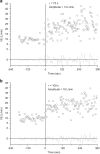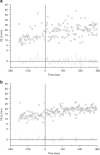Effects of overground locomotor training on the ventilatory response to volitional treadmill walking in individuals with incomplete spinal cord injury: a pilot study
- PMID: 28435743
- PMCID: PMC5390072
- DOI: 10.1038/scsandc.2017.11
Effects of overground locomotor training on the ventilatory response to volitional treadmill walking in individuals with incomplete spinal cord injury: a pilot study
Abstract
Introduction: Although there has been substantial emphasis on the neuromuscular and cardiovascular adaptations following rehabilitation, pulmonary adaptations in individuals with incomplete SCI (iSCI) in response to locomotor training have been less frequently studied. In healthy individuals, effective transition from rest to work is accomplished by a hyperpneic response, which exhibits an exponential curve with three phases. However, the degree to which our current understanding of exercise hyperpnea can be applied to individuals with iSCI is unknown. The purpose of this case series was to characterize exercise hyperpnea during a rest to constant work rate (CWR) transition before and after 12-15 weeks of overground locomotor training (OLT).
Case presentation: Six subjects with cervical motor incomplete spinal cord injury participated in 12-15 weeks of OLT. Subjects were trained in 90-min sessions twice a week. All training activities were weight-bearing and under volitional control without the assistance of body-weight support harnesses, robotic devices or electrical stimulation. Six minutes of CWR treadmill walking was performed at self-selected pace with cardiorespiratory analysis throughout the tests before and after OLT. Averaged group data for tidal volume, breathing frequency or VE showed no difference before and after training. VE variability was decreased by 46.7% after OLT.
Discussion: CWR VE from rest to work was linear throughout the transition. Following OLT, there was a substantial reduction in VE variability. Future research should investigate the lack of a phasic ventilatory response to exercise, as well as potential mechanisms of ventilatory variability and its implications for functional performance.
Keywords: Rehabilitation; Trauma.
Conflict of interest statement
The authors declare no conflict of interest.
Figures



Similar articles
-
Effect of overground locomotor training on ventilatory kinetics and rate of perceived exertion in persons with cervical motor-incomplete spinal cord injury.Spinal Cord Ser Cases. 2019 Sep 26;5:80. doi: 10.1038/s41394-019-0223-7. eCollection 2019. Spinal Cord Ser Cases. 2019. PMID: 31632738 Free PMC article.
-
Effect of repeated locomotor training on ventilatory measures, perceived exertion and walking endurance in persons with motor incomplete spinal cord injury.Spinal Cord Ser Cases. 2020 Oct 12;6(1):94. doi: 10.1038/s41394-020-00346-6. Spinal Cord Ser Cases. 2020. PMID: 33046694 Free PMC article.
-
Effects of Overground Locomotor Training on Walking Performance in Chronic Cervical Motor Incomplete Spinal Cord Injury: A Pilot Study.Arch Phys Med Rehabil. 2017 Jun;98(6):1119-1125. doi: 10.1016/j.apmr.2016.10.022. Epub 2016 Dec 11. Arch Phys Med Rehabil. 2017. PMID: 27965006
-
Training with robot-applied resistance in people with motor-incomplete spinal cord injury: Pilot study.J Rehabil Res Dev. 2015;52(1):113-29. doi: 10.1682/JRRD.2014.03.0090. J Rehabil Res Dev. 2015. PMID: 26230667 Clinical Trial.
-
Locomotor training after human spinal cord injury: a series of case studies.Phys Ther. 2000 Jul;80(7):688-700. Phys Ther. 2000. PMID: 10869131 Review.
Cited by
-
Electrical stimulation of the sciatic nerve restores inspiratory diaphragm function in mice after spinal cord injury.Front Neural Circuits. 2025 Jan 22;18:1480291. doi: 10.3389/fncir.2024.1480291. eCollection 2024. Front Neural Circuits. 2025. PMID: 39911754 Free PMC article.
-
Mechanism-Based Neuromodulation in Augmenting Respiratory Motor Function in Individuals with Spinal Cord Injury.J Clin Med. 2025 May 29;14(11):3827. doi: 10.3390/jcm14113827. J Clin Med. 2025. PMID: 40507584 Free PMC article. Review.
-
Effect of overground locomotor training on ventilatory kinetics and rate of perceived exertion in persons with cervical motor-incomplete spinal cord injury.Spinal Cord Ser Cases. 2019 Sep 26;5:80. doi: 10.1038/s41394-019-0223-7. eCollection 2019. Spinal Cord Ser Cases. 2019. PMID: 31632738 Free PMC article.
-
Overground Locomotor Training in Spinal Cord Injury: A Performance-Based Framework.Top Spinal Cord Inj Rehabil. 2017 Summer;23(3):226-233. doi: 10.1310/sci2303-226. Top Spinal Cord Inj Rehabil. 2017. PMID: 29339898 Free PMC article.
-
Locomotor-respiratory coupling in ambulatory adults with incomplete spinal cord injury.Spinal Cord Ser Cases. 2022 Apr 30;8(1):49. doi: 10.1038/s41394-022-00515-9. Spinal Cord Ser Cases. 2022. PMID: 35501342 Free PMC article.
References
-
- Schilero GJ, Spungen AM, Bauman WA, Radulovic M, Lesser M. Pulmonary function and spinal cord injury. Respir Physiol Neurobiol 2009; 166: 129–141. - PubMed
-
- Linn WS, Adkins RH, Gong H Jr, Waters RL. Pulmonary function in chronic spinal cord injury: a cross-sectional survey of 222 southern California adult outpatients. Arch Phys Med Rehabil 2000; 81: 757–763. - PubMed
-
- Linn WS, Spungen AM, Gong H Jr, Adkins RH, Bauman WA, Waters RL. Forced vital capacity in two large outpatient populations with chronic spinal cord injury. Spinal Cord 2001; 39: 263–268. - PubMed
-
- Olive JL, Dudley GA, McCully KK. Vascular remodeling after spinal cord injury. Med Sci Sports Exerc 2003; 35: 901–907. - PubMed
LinkOut - more resources
Full Text Sources
Other Literature Sources

